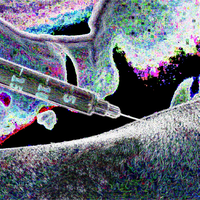| Baclofen | |
|---|---|
| Salts [] | |
|---|---|
| Baclofen hydrochloride | |
| Molecular structure via molpic | |
| Molecular formula | C10H12ClNO2[1] |
|---|---|
| Molecular mass | 213.66 g/mol[1] |
| Predicted LogP | -1[1] |
| Melting point | 372 to 376 °F (NTP, 1992)[1] |
| Solubility | less than 1 mg/mL at 64 °F (NTP, 1992)[1] |
| Chirality | racemic[2] |
| Identifiers [] | |
|---|---|
| IUPAC name | 4-amino-3-(4-chlorophenyl)butanoic acid[1] |
| SMILES | C1=CC(=CC=C1C(CC(=O)O)CN)Cl[1] |
| InChI | InChI=1S/C10H12ClNO2/c11-9-3-1-7(2-4-9)8(6-12)5-10(13)14/h1-4,8H,5-6,12H2,(H,13,14)[1] |
| InChIKey | KPYSYYIEGFHWSV-UHFFFAOYSA-N[1] |
| Dosing | |
|---|---|
| Elimination half-life | 2.5 to 7 hours |
| Oral [] | |
|---|---|
| Threshold | 10 mg |
| Light | 10 - 20 mg |
| Common | 20 - 40 mg |
| Strong | 40 - 50 mg |
| Heavy | 50 - 80 mg |
| Statistically derived dosages by Sernyl |
Baclofen
(Redirected from (+)-Baclofen)
Baclofen (also known as 4-Amino-3-(4-chlorophenyl)butanoic acid, Baclon, Kemstro, DL-Baclofen, Baclofene, Baclofeno, Gabalon, (+-)-Baclofen, Baclofenum or Baclophen) is a substance of the gabapentinoid class.
Chemistry
Baclofen is typically found in the form of its hydrochloride salt.
Stereochemistry
(RS)-Baclofen is a racemic mixture of the optical stereoisomers:
| Stereoisomers [] |
|---|
Legal status
- Australia: Baclofen is a S4 substance.
- Canada: Baclofen is a prescription only substance.
- New Zealand: Baclofen is a Prescription only substance.
- United Kingdom: Baclofen is a prescription only substance.
- United States: Baclofen is a prescription only substance.
See also
External links
- Baclofen (Wikipedia)
- Baclofen / (+)-Baclofen / (-)-Baclofen (Wikidata)
- Baclofen / (+)-Baclofen / (-)-Baclofen (DrugBank)
- Baclofen / (+)-Baclofen / (-)-Baclofen (PubChem)
- Baclofen / (+)-Baclofen / (-)-Baclofen (ChEMBL)
- Baclofen / (-)-Baclofen (ChEBI)
- Baclofen / (+)-Baclofen / (-)-Baclofen (Common Chemistry)
- Baclofen (HMDB)
- Baclofen / (-)-Baclofen (KEGG)
- Baclofen / (+)-Baclofen / (-)-Baclofen (UNII)
- Baclofen / (-)-Baclofen (EPA DSSTox)
 Anodyne
Anodyne